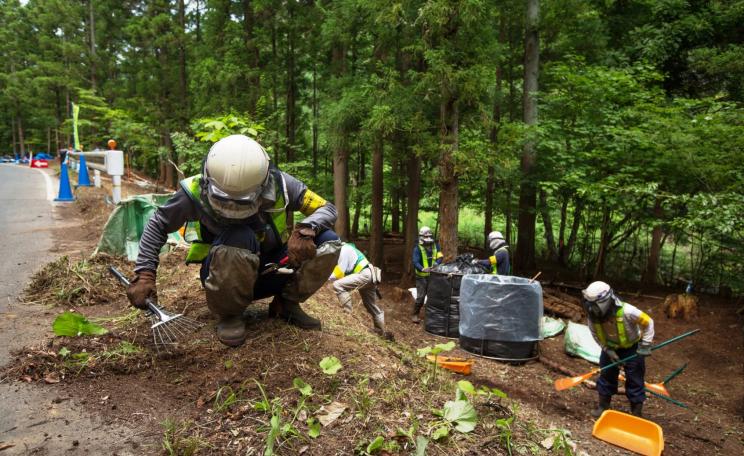The continued use of nuclear power poses a constant risk of proliferation.
Nuclear lobbyists have jumped on the recent report of the Intergovernmental Panel on Climate Change (IPCC) to promote nuclear power. In so doing they misrepresent the IPCC report.
World Nuclear Association Director General Agneta Rising said the IPCC report "makes clear … the necessity of nuclear energy as an important part of an effective global response" to climate change.
She argues that it "highlights the proven qualities of nuclear energy as a highly effective method of reducing greenhouse gas emissions, as well as providing secure, reliable and scalable electricity supplies."
In a separate statement, the association falsely claimed that nuclear power increases under all of the IPCC scenarios compatible with limiting warming to 1.5˚C.
The IPCC report does indeed have some nice things to say about nuclear power. For example it argues that, "comparative risk assessment shows health risks are low per unit of electricity production and land requirement is lower than that of other power sources".
But the report also raises numerous concerns. It states that historically high rates of scalability and speed of scaling of nuclear plants "are not achieved anymore" and "the current time-lag between the decision date and the commissioning of plants is observed to be 10-19 years."
The IPCC report states that the deployment of nuclear energy is "constrained by social acceptability in many countries" due to concerns over risks of accidents and radioactive waste management.
It states that: "The long-term storage of nuclear waste is a politically fraught subject, with no large-scale long-term storage operational worldwide."
It mentions studies finding an increased incidence of childhood leukaemia in populations living within five kilometres of nuclear power plants - the evidence of a link is actually stronger than the IPCC suggests.
The IPCC report notes that the costs of nuclear power have increased over time in some developed nations "principally due to market conditions where increased investment risks of high-capital expenditure technologies have become significant".
It notes that nuclear power provides an example of "where real-world costs have been higher than anticipated ... while solar PV is an example where real-world costs have been lower".
The continued use of nuclear power poses a constant risk of proliferation.
Weapons proliferation
The IPCC report states that "continued use of nuclear power poses a constant risk of proliferation." Michael Shellenberger, a nuclear lobbyist in the US, calls this "unsubstantiated fear-mongering".
But Shellenberger himself has recently written at length about the manifold and repeatedly-demonstrated connections between nuclear power and weapons.
"[N]ational security, having a weapons option, is often the most important factor in a state pursuing peaceful nuclear energy," Shellenberger said in August.
A recent analysis by Shellenberger's nuclear lobby group 'Environmental Progress' found that of the 26 nations that are building or are committed to build nuclear power plants, 23 have nuclear weapons, had weapons, or have shown interest in acquiring weapons.
"While those 23 nations clearly have motives other than national security for pursuing nuclear energy," Shellenberger wrote, "gaining weapons latency appears to be the difference-maker."
Walking back his earlier statements linking nuclear power and weapons, Shellenberger writes in his response to the IPCC report that: "No nation has used its civilian nuclear plants to create a weapon."
That claim is garbage: nuclear power reactors have been used directly for weapons production, as have technologies association with nuclear power ‒ enrichment and reprocessing plants, and research and training reactors.
Nuclear power's decline
On October 16, The Australian newspaper published an opinion piece by Tony Grey headlined 'Turns out that even the Greens see nuclear sense'. The 'Greens' in this case are the climate scientists who contributed to the IPCC report.
According to Grey, the IPCC report "offers a refreshing view on nuclear power’s role in helping to mitigate global warming. It’s refreshing because the green lobby has been such a closed-minded opponent."
Grey continues: "The inescapable inference from the report is that without its contribution, there would be no possibility of achieving the objective the IPCC calls for."
Grey misrepresents the IPCC report. The report states: "Nuclear power increases its share in most 1.5°C pathways by 2050, but in some pathways both the absolute capacity and share of power from nuclear generators declines.
"There are large differences in nuclear power between models and across pathways … Some 1.5°C pathways no longer see a role for nuclear fission by the end of the century, while others project over 200 EJ / yr of nuclear power in 2100."
Marginal contributor
Nearly all of the scenarios presented in the IPCC report envisage a decline in nuclear power generation to 2030 followed by an upswing. No logical rationale ‒ or any rationale at all ‒ is provided to support the upswing from 2030 to 2050.
All we know for sure is that an overwhelming majority of the world's ageing fleet of nuclear power reactors will be shut down by 2050, and it seems increasingly unlikely that the number of reactor start-ups will match shut-downs.
But even if nuclear power does enjoy an upswing, it will still be a marginal contributor to energy supply and to climate change abatement. The points that jump out from most the IPCC's low-carbon 1.5°C scenarios are that nuclear accounts for only a small fraction of energy/electricity supply (even if nuclear output increases) whereas renewables do the heavy lifting.
For example, in one 1.5°C scenario highlighted in the report, nuclear power more than doubles by 2050 but only accounts for 4.2 percent of primary energy whereas renewables account for 60.8 percent. In another 1.5°C scenario, nuclear nearly doubles by 2050 but its contribution to total electricity supply falls to 8.9 percent (from 10.3 percent in 2017), compared to 77.5 percent for renewables.
This Author
Dr. Jim Green is the national nuclear campaigner with Friends of the Earth Australia and editor of the Nuclear Monitor newsletter, where a version of this article was originally published.







